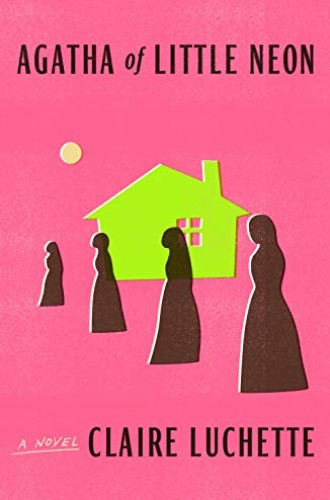Sister Agatha roller-skates away from the church
The heroine of Claire Luchette’s novel realizes she became a nun to avoid being herself.
As Catholic religious sisters dwindle in numbers, age into old folks’ homes, and sell off their mother houses and hospitals, younger sisters increasingly have to find new ways to live out their vows of poverty, chastity, and obedience without the accompaniment of their peers. In Claire Luchette’s debut novel, four young sisters must make a new life for themselves when the day care they’ve been running closes its doors and their elderly superior retires. Instead of caring for babies, praying in their idyllic cathedral, and marketing small-batch mustards and aiolis, they’ve been called to care for recovering addicts and felons as the staff of Little Neon, a halfway house painted discount chartreuse in Woonsocket, Rhode Island, where the rusted water tower is about as idyllic as it gets.
Fiction about religious sisters tends toward the sentimental or the horrific, and Luchette’s Sister Agatha alludes to this convention when she remarks that nuns are either naive, charming, and jolly or “wicked, frustrated, sexually repressed.” Luchette deftly avoids the clichés of the genre, giving us instead flawed and frustrating but relatable characters—sisters and convicted felons alike.
In the early chapters, Luchette’s sisters move beautifully as one: “We were fixed to one another, like parts of some strange, asymmetrical body: Frances was the mouth; Mary Lucille, the heart; Therese, the legs. And I, Agatha, the eyes.” They menstruate at the same time. But as we read on, we begin to suspect, as she does, that Agatha chose being part of a larger body to avoid being herself.
As the sexual abuse scandals come to light, some of the sisters plug their ears and pray louder. Agatha seems to slowly come awake from the dream that she was ever responding to God’s call at all. In her first striking act of independence (and one of the most moving passages in a novel full of powerfully rendered vignettes), she sneaks into the garage of Little Neon one night after her sisters go to sleep on their cramped twin beds in the airless attic. Her desire? To try out a pair of old, too small, “stiff-heeled” roller skates she found. “I never told the others. It was the first decision I made on my own in Woonsocket, the first thing I kept to myself. No permission, no approval, no company. No one to sidetrack me from what I wanted, which was to soar across the cement.”
She doesn’t quite soar: her first try is “graceless and inept.” When she’s found out by another resident of Little Neon, Tim Gary, he offers to help by providing old construction safety gear and his experience as a former hockey player. It’s Gary who encourages Agatha to venture beyond the garage and into the night:
I’m still not sure what scared me more as I stood and looked into the dark with little wheels on my feet: staying there, or not staying there. But the night looked lovely and wild and immense, and so I lunged headlong onto the driveway before I could talk myself out of it. The only sound was the skate wheels spinning on the blacktop and thwacking over the cracks and then I was there, on the street, and I dragged my right toe to stop. When I turned around Little Neon looked blue in the night, and I could see that Tim Gary was grinning, radiant under the bare bulb that hung in the garage. He called to me in a whisper that was also a shout. “You did it! You did it!”
Roller-skating is her first step away from the sisters’ shared body, and ultimately the body of the church.
It turns out Agatha is also called to teach geometry at the local Catholic school, though she has no desire to teach and no experience as a teacher of anything. The job takes her farther from the life of her sisters who stay behind at Little Neon during their days. As Agatha steps away from that shared life and into new experiences and friendships, something interesting happens. She begins to want. “Oh, it turns your insides sick when you let yourself want things,” Sister Mary Lucille says, but Agatha begins to reckon with everyday desire—not only for intimacy but also for everyday indulgences, like choosing the best pastry from the case instead of waiting until parishioners have had their fill after mass and being left with a stale blueberry cake donut:
I wanted to choose a pretty one. I wanted sprinkles, glaze, cream filling, chocolate frosting, cinnamon sugar. I wanted the cutest, fluffiest one, waiting for me behind glass, and I wanted it warm and soft and on a paper plate, next to a white Styrofoam cup of black coffee so hot it burned the roof of my mouth. I wanted the roof of my mouth to peel off in strips. And I wanted it all, right then.
While teaching herself geometry, Agatha begins to wonder about how she fits. “I had no real defense of geometry,” she says, “except that it seemed to be our means of knowing the shape of things, and assessing our place in the world relative to everything else.” But as she continues to allow herself to take up space of her own, she finds no easy grace or freedom. She has never before wanted to be anything apart from her sisters. Still, her rage at the daily injustices and downright horrors she sees in the church mounts until she can no longer keep her place: “I have loved church since childhood, back when I first knew grief, when I learned what it meant to have a mother die. Helpless me. I had no idea that the church could break your heart.”
Agatha’s final confession, made to a priest, stayed in my head for days after I read the last pages of her story. “I have looked at the world and found it wanting,” she says. “The world has had women for such a long time. . . . I did not know how to be patient anymore.” The church has become a place of betrayal and yet, with her sisters, there is the consolation of having each other. Without them, she would need to confront the terror of being her own person, of reconfiguring herself in relationship to the world without the guidance of a larger body.
She finds herself at mass contemplating the mural of Mary and the angels:
Before, it had always brought me hope. But it devastated me then. I knew it was supposed to be a joyous moment for Mary, but I fixated on the details of life on earth, the palm tree behind Luke. There was a cost to salvation, I understood. I’d never considered how unbearably sad it was to have to leave so much behind.
Though we as readers perhaps have been rooting for Agatha to leave, we know that if she does, her exit will be not a triumph but a grief.






